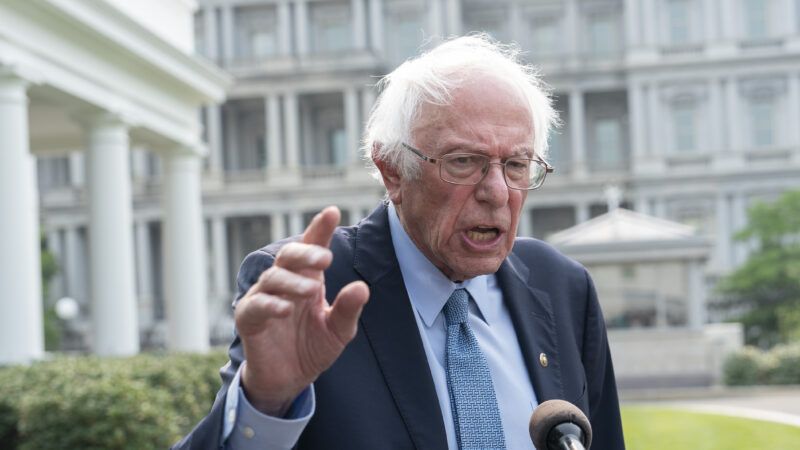Bernie Sanders Introduces a Bill To Raise Minimum Wage to $17 by 2028
The proposal would raise the federal minimum wage by 134 percent.

Congressional Democrats have tried numerous times to raise the federal minimum wage to $15 an hour. Now they're back with an even bigger proposal.
On July 25, a group of 30 Democratic Senators and 150 House members led by Sen. Bernie Sanders (I–Vt.) and Rep. Bobby Scott (D–Va.) introduced the Raise the Wage Act of 2023, which would increase the federal minimum wage to $17 by 2028. The bill also removes the sub-minimum wage for tipped workers and youth workers over seven years, and for workers with disabilities over five years.
Proponents of raising the minimum wage tout it as an anti-poverty tool. "The $7.25 an hour federal minimum wage is a starvation wage. It must be raised to a living wage—at least $17 an hour. In the year 2023 a job should lift you out of poverty, not keep you in it," Sanders said in a press release.
As the Economic Policy Institute shows, over 12 percent of workers in 2022 were paid below the poverty level ($13.33 per hour) and 20 states don't have a minimum wage above the federal level ($7.25 per hour). Advocates note that the minimum wage has not tracked productivity growth, in which case it would be $23 an hour since its peak in 1968, and $42.37 if it aligned with the growth of Wall Street bonuses since 1985.
"Due to high inflation, $17 per hour today is roughly equivalent to $15 per hour in late 2019 in terms of its real spending power," explains Ryan Bourne, the R. Evan Scharf chair for the Public Understanding of Economics at the Cato Institute. "So I see this from Sanders and company as a continuation of the Fight for $15 campaign, albeit with a higher cash wage to reflect the recent burst of inflation."
However, the minimum wage has proven to be a poor tool for reducing poverty because of its impact on employment, especially for younger, less educated, or less skilled workers.
"Raising the federal minimum wage by 134% to $17 per hour would do very little to alleviate poverty and will hurt many of the workers Senator Sanders purports to help," adds Joseph J. Sabia, professor and new chairman of the Economics Department at San Diego State University. For example, raising the minimum wage to $15 per hour in New York City led businesses to cut staff and hours.
A July study on the proposal by the economists William Even of Miami University and David Macpherson of Trinity University, released by the Employment Policy Institute, finds that raising the minimum wage to $17 per hour would lead to the loss of over 1.2 million jobs nationwide. Notably, they find that 63 percent of the job losses would be borne by workers between 16 and 24 years old and that tipped workers will experience a quarter of the job losses in restaurants and bars, two of the demographics that Sanders' and Scott's bill explicitly aims to help.
"Research has shown that teenagers are affected more by a minimum wage hike," says Even. "One might say maybe we shouldn't worry about that, but there's other research showing that what you do as a teenager has a long-run effect on your labor market opportunities."
There is also the impact of rising prices resulting from the minimum wage, which disproportionately affects poor households. "Jacking up the price of takeaway food, hospitality services, and others clearly means that a minimum wage increase is not an unalloyed good for low-income households," explained Bourne in a 2021 Medium piece.
"If you think about it, fast food restaurants are going to be disproportionately affected. The luxury restaurants are probably paying waiters and waitresses above the minimum wage anyway," notes Even. "And so where the prices are affected more happens to be where low-income people are more likely to buy food."
While some research has found that minimum wage increases do not cause job loss, most scholarship indicates a negative relationship. In a 2022 working paper for the National Bureau of Economic Research, economists David Neumark of the University of California Irvine and Peter Shirley, director of the Joint Committee on Government and Finance for the West Virginia Legislature, examined "the entire set of published studies in this literature" and find that "there is a clear preponderance of negative estimates in the literature."
"Newer research also shows that some firms react in other ways than laying off workers or reducing future hiring. This might be through trimming non-pay benefits, forcing their workers to work harder, replacing low-skilled workers with higher-skilled workers, or altering work schedules in ways less well suited to workers' lives," notes Bourne. "This might reduce the effect on overall employment, but all of these things have downsides for the low-wage workers directly affected. There are big trade-offs."
The minimum wage's effect also depends on where it is implemented. "Minimum wages may have different 'bite' across different regions of the country because of differences in the shares of low-wage workers living (or working) there," explains Sabia. "For instance, in Los Angeles, California, the local minimum wage is $16.78 per hour. A $17 federal minimum wage is likely to have much less impact there than in Oxford, Mississippi, where the minimum wage is $7.25 per hour."
The desire to increase the federal minimum wage may originate from a genuine desire to help workers, but the evidence says it will do real harm.
Show Comments (86)